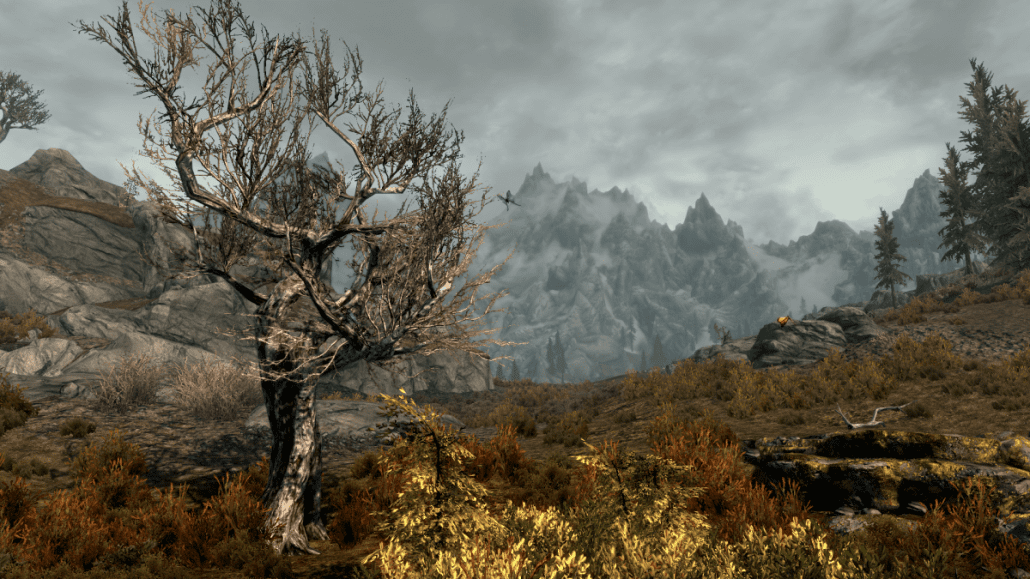What is a bad game design?
That’s an ambitious question to ask. Bad game design is so multi-faceted that you should analyze it game by game, genre by genre, and in some cases, level by level. However, in this blog post, I want to talk about a guiding principle that many games, from many genres, can follow and avoid many of the pitfalls of a bad game design. There’s no point in creating mystery around it; you have read the title, so you know what it is. It’s all the elements in the game that you have a hard time giving a shit about.
How is bad design displayed in games?
Now, Bad game design comes as a surprise, but a considerable number of games suffer from this issue, with some of them actually being universally loved games. They have only one weapon, inventory item, game-play mechanic, and area/level with which no one likes to engage. The game’s fans barely discuss it, and everyone knows it’s just there to create a false impression of variety or depth.
At the risk of sounding like a radical, I’m here to make a claim: the greatness of your game is determined by how well the player knows all of its different elements, like the back of his hand. Some developers assume that they can add stuff to the game, and in the worst-case scenario,
if some of them are not working, the player won’t use them; they’ll stick to the good stuff. But they don’t consider how badly this extra useless element hurts players’ assumptions about the game. When every little thing is working, the player feels comfortable dedicating time and energy to gain mastery over the game or know it deeply. The temptation to deeply know something or reach mastery over something well thought out is enormous. But the trick is gone when there’s even one useless element in the game because the player can’t look at the game with reverence anymore. They already feel one step ahead of the developer because they assume the developers didn’t bother to determine what works and doesn’t in their own game.
Why should they?
When you look at all the video game titles that became classics (Super Mario 64, Metal Gear, Starcraft, Dota 2, Counter Strike’s De Dust 2, Resident Evil, Shadow of Colossus, etc.), they all have one thing in common: they have a very tight and focused bad game design in all the parts that matter.
For example, when you talk to a Resident Evil fan, they might still remember the layout of Spencer Mansion after decades. That’s because the original Residents Evils demanded that level of attention from you. They used the element of horror to force you into knowing what’s behind every door and where every hallway leads to because if you kept wandering around absent-mindedly, you would be punished by jump scares.
When you watch Starcraft matches by professional players, you’ll see that every single unit and building in the game can be crucial in different scenarios. There’s not a single thing you can classify as useless. Thanks to the game’s strict “Rock Paper Scissors” mindset, every unit and strategy is countered by something else. This is why this game kickstarted the whole esports scene. It works like a symphony, and watching professionals perform it is a joy.
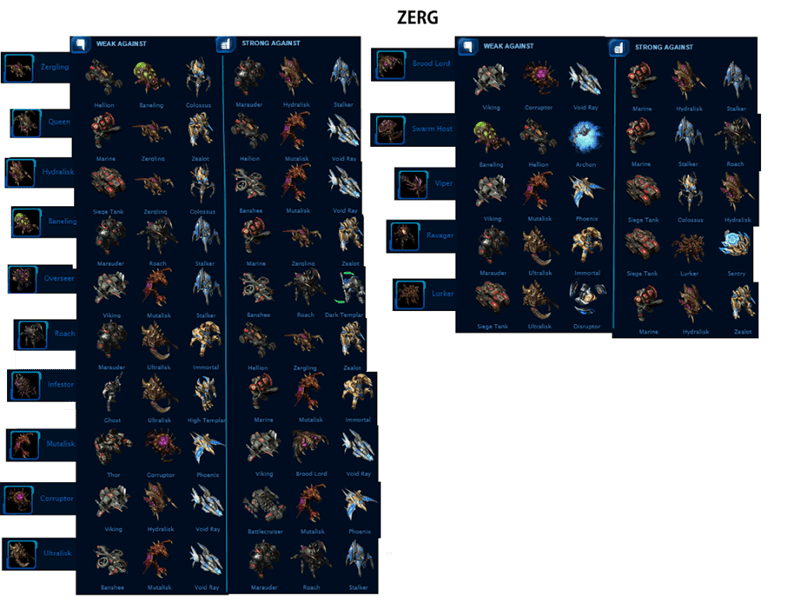

The same logic applies to all the other games mentioned:
- Super Mario 64 is classic because every movement, every platform, and enemy placement is well-thought.
- Dota 2 has become a time-sinker for millions because its numerous champions and items can be useful in certain situations, creating insane depth.
- Shadow of the Colossus is a minimalist masterpiece because you only have a sword and a bow, and you never feel like the game could be much better if there were a mace and spear too.
- De_Dust2 map has become famous because every single spot on the map can be used for strategic advantage.
The message is clear: video games work best when they force players to care about every little detail. It shouldn’t be there if the player has difficulty caring about it, even if it technically doesn’t hurt the game.
You might say: well, that’s obvious. Why are you acting like this is a big revelation? My answer to you would be: is it really that obvious? Because throughout the years, many gameplay mechanics became normalized -especially in the AAA industry- that go against this whole theory. To mention a few:
- Limitless fast travel
- Automatic level up
- A procedurally generated environment that looks the same
- Big open worlds filled with vacant spaces
- Unlockables and collectibles that are glorified B.F. Skinner experiments
The prevalence of this feature in the game industry
These mechanics and features have become so prevalent in the game industry that people somehow take them for granted, and we’re seeing them in more and more bad game design. But my concern is that they make games worse in general. Why? They make the player play the game on auto-pilot mode for a simple reason. That isn’t good. Playing games on auto-pilot mode is the recipe for a forgetful experience.
For example, imagine you have a Diablo clone with a skill tree, but the player can make the game automatically pick the most useful skill for them every time they level up. In the current discourse of bad game design, that’s just a way to make it convenient for the player to advance in the game without bothering with the more technical nuances. But that begs the question: if you can advance without even reading the description of a skill/attribute, what’s the point of this system’s existence in the game in the first place?
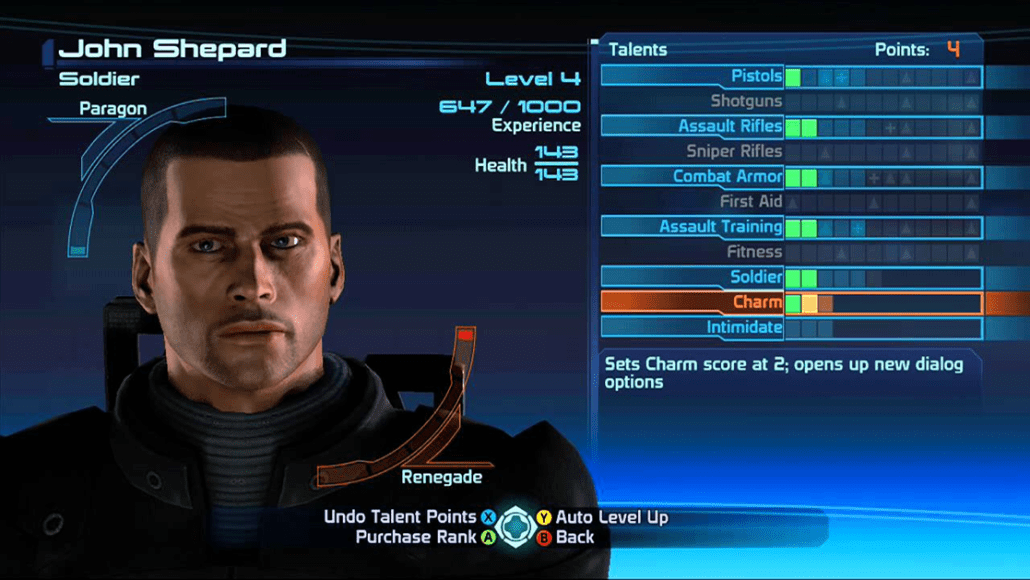

The Common Issues
That’s the issue here. Many games have features because they’re trendy (i.e., open world, skill tree, procedural generation), but the game doesn’t need them. This is because they have fallen victim to the latest trend.
So far, the point has been clear. Players should care about everything included in the bad game design. You might ask: but how? Some people show different reactions to everything. You might put something in the game that someone finds extremely useful/interesting while someone else doesn’t.
To that, I answer: that’s perfectly fine and in line with what I’m preaching, but as long as it is happening. But sometimes, video game developers claim things that can’t help but raise your eyebrows. For instance, Bethesda claimed Starfield would have 1000 explorable planets a while back.
The fact that this claim is something you say to sell your game shows how messed up the game industry has become. Starfield is not out yet, and who knows, maybe when it’s out, it will turn out to be the best thing since sliced bread. But as PC Gamer put it: “there’s no way all 1000 explorable planets in Starfield are actually interesting”. Because there are not enough resources in the world to design 1000 planets meaningfully, the game will have 10 really interesting planets. The rest are probably used for farming resources and XP in samey environments.
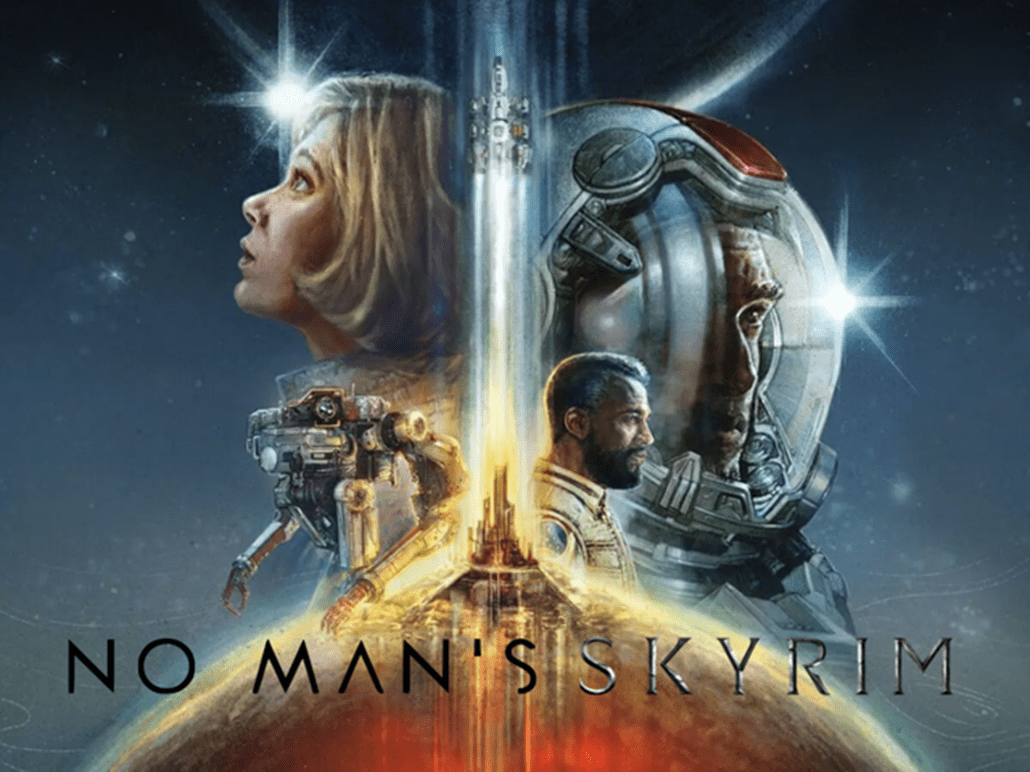

(Relax, we know No Man’s Sky eventually got good)
I have a problem with this “the bigger, the better” theory that companies like Bethesda and Ubisoft follow. There’s a good game underneath these companies’ bloated messes, but all the time-sink crap they include kind of ruins that.
When I was playing Assassin’s Creed 3, I remember enjoying the game’s main content. Relieving important historical events of the American Revolution was amazing. But then, there was a lot of side content that I was doing because of my completionist attitude. This site content felt like a chore after a while because it required much effort for a minor achievement. The benefits they provided for gameplay were irrelevant (because the game was not hard enough), and story-wise… well, I’m sure someone will find meaning in helping Prudence herding her pigs, but that someone ain’t me.
The dilemma is easy for some of you: if you don’t enjoy side content, don’t do it. And many people didn’t actually go after Assassin’s Creed 3’s side content and made fun of their trivial nature. But why even make something 90% of people are not going to play, and the other 10% will feel like they’re wasting their time doing it and only do it because their completionist OCD curses them?


How different companies face this issue
Sadly, many of these companies had the right idea at some point in their careers. But because of this stupid “GO BIGGER” mentality, they shot themselves in the foot. For example, the Youtube channel Gamedev Adventures has an excellent video titled: An Example of Fast Travel Done Right. The example is from The Elder Scrolls III: Morrowind.
This game has a fascinating solution to making fast travel engaging. It is simple: you’re not free to go anywhere you have discovered. There is a network of transportation that you have to get familiar with. To explain it in simple terms, there are three ways you can use to get around Morrowind:
- Weird Lovecraftian creatures called Silt Striders
- Boats located in port cities
- The Mage Guild’s teleport devices
The neat thing is that none of these methods replace the other. Each covers certain areas and cities and has unique features that make sense in the game world context. Take a look at the map:
The blue lines are the transportation lines of the boats. Obviously, they can only take you to port cities.
The red lines are the transportation lines between the 5 mage guilds because those are the only five cities in which a mage guild is located.
The yellow lines are the transportation lines between Silt Strider stations. They can only serve the western and southern parts of the world because there is a dangerous area in the middle of the map (the big vacant area) that no Silt Strider can get through.
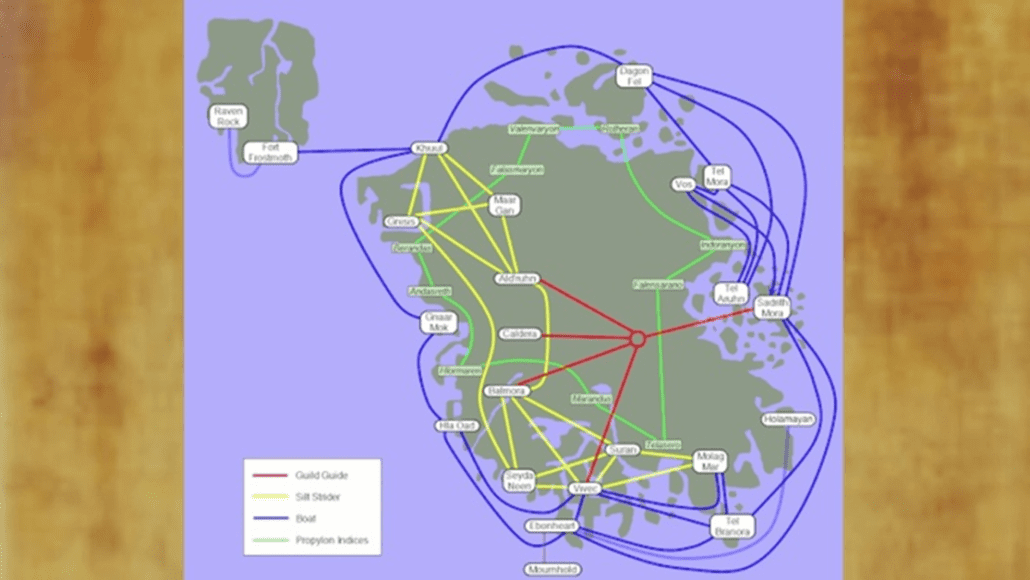

As you can see, there’s so much logic behind this fast travel system. The bad game design forces the player to care about the nature of places and the kind of service they can logistically provide. The cool thing is that this fast travel system interacts with your decisions inside the game. For example, if you have a good relationship with the mage guild, they will reduce their prices for teleportation. But if you get on their wrong side, they will refuse service, forcing you to walk long distances to get where you want.
Now compare this with the fast travel system of Oblivion. You have many locations on the map, which are effectively the copy-paste versions of one umbrella location (dungeon, elven ruin, etc.). As soon as you get near their vicinity, they become an identified location on the map that you can fast-travel to at any time, without any expense. This system continued to exist in Skyrim.
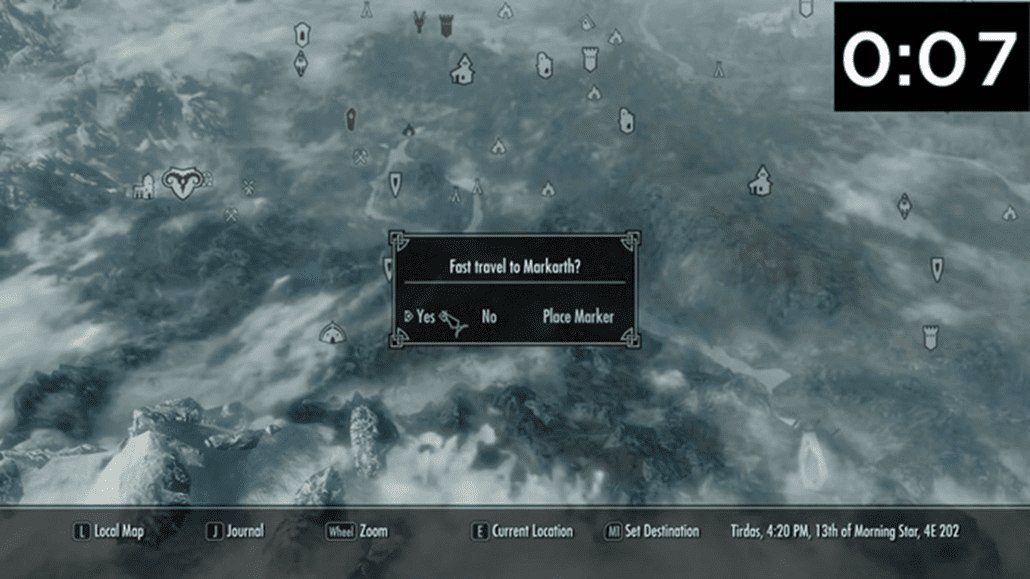

It’s a shame to see that Bethesda already had such an engaging, fast travel system in Morrowind and then gave it up for the most vanilla and boring fast travel system you can imagine in the sequels. It’s like they regressed. It’s ironic somehow, but the increased size of the game world in Oblivion and Skyrim makes them feel more and more linear after a while. Because you are just jumping around between locations without ever feeling the need to care about their function in the game world. At least in the case of Oblivion, there’s not much incentive not to use the fast travel system because the environments look similar. The only incentive is the weird RPG system that actually levels up your “Walking” skill, basically blackmailing you into walking like a Dollard.
The contrast between Morrowind and Oblivion/Skyrim’s fast travel system makes this article crystal clear. In its quest to get bigger, the game industry is constantly putting stuff in content spam games. I know “people should care about your content” seems like such an obvious thing to say. But judging by the directions that some game companies are taking their game, it definitely needs to be said.
All these expensive, forgettable bloated messes that big publishers make result from ignoring this one key realization: Anything that makes the player not care is bad game design.
It’s true that some AAA companies -like Naughty Dog- have extensive playtest sessions and even record the playtesters’ facial reactions to see when they show signs of boredom. You might find it interesting that a player getting bored in a specific part of the game could officially be considered a bug. They can find useless elements in their game if they go that far. But not everyone has the means to do such extensive playtesting. Sometimes, all you need is to rely on your own common sense and admit that making 1000 explorable planets doesn’t sound as cool as you think.

